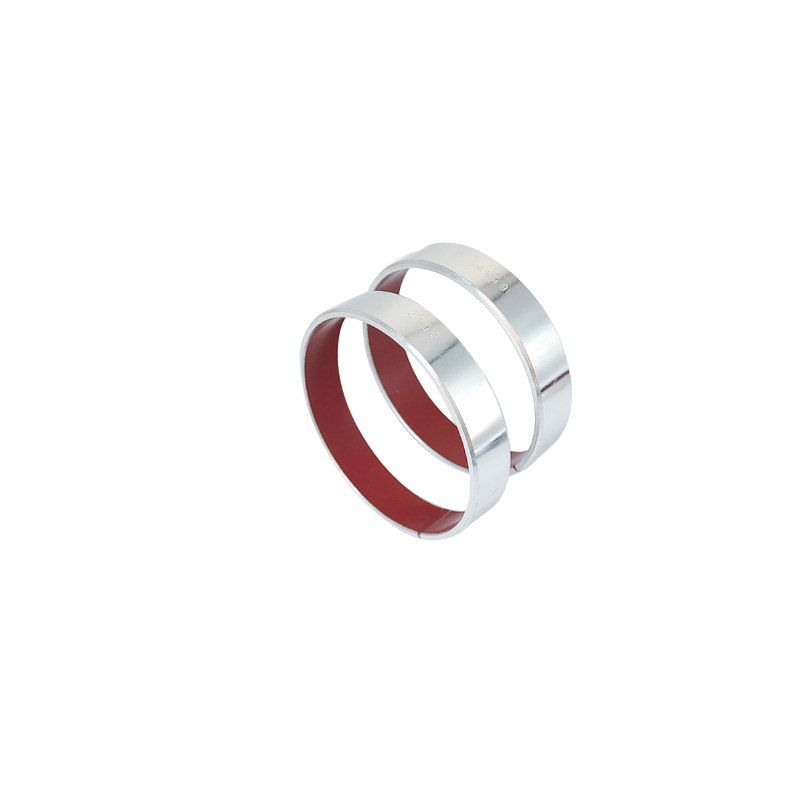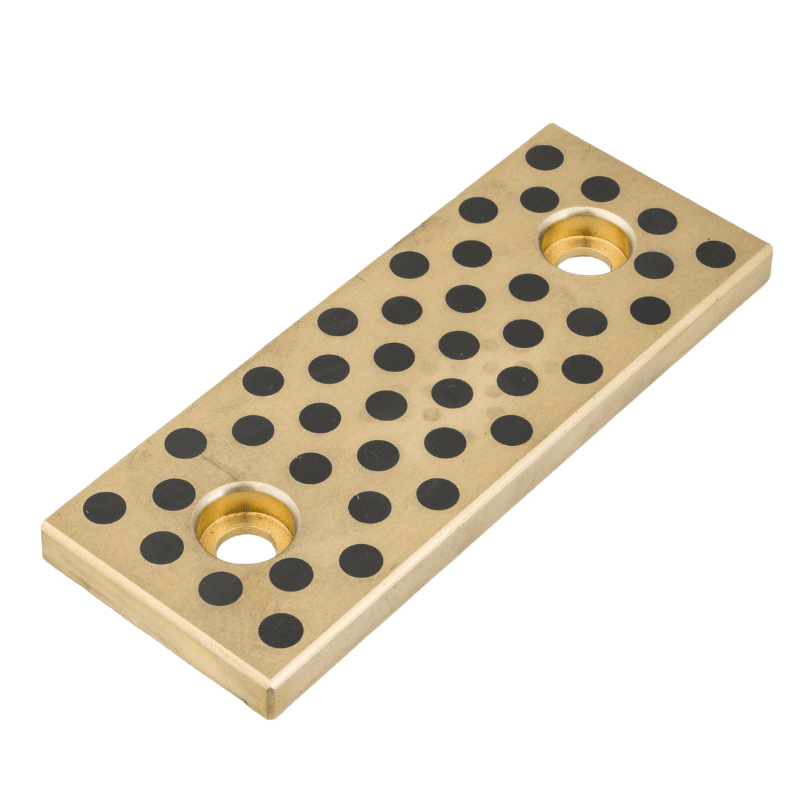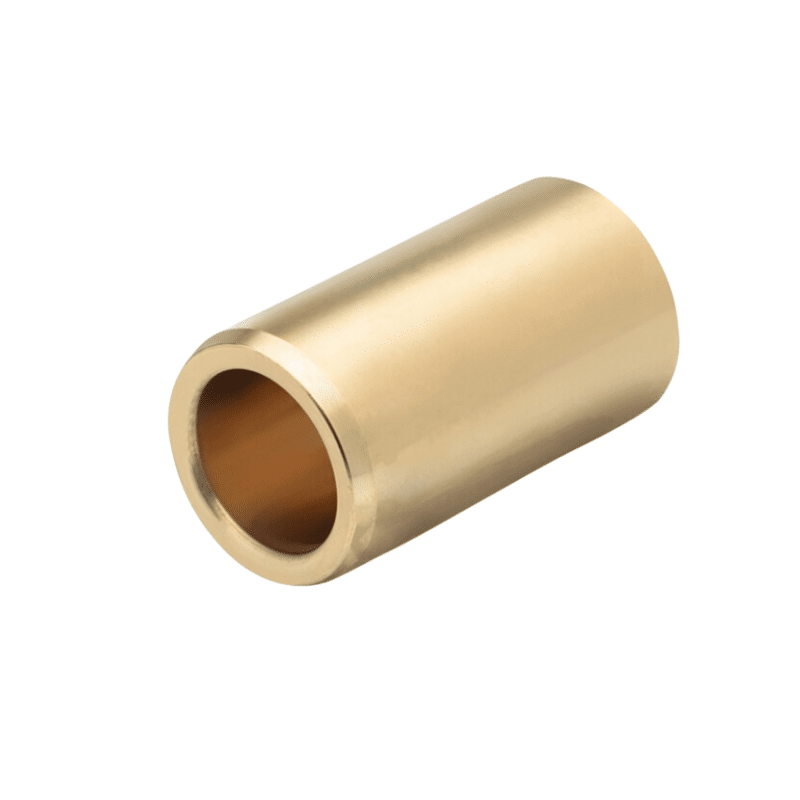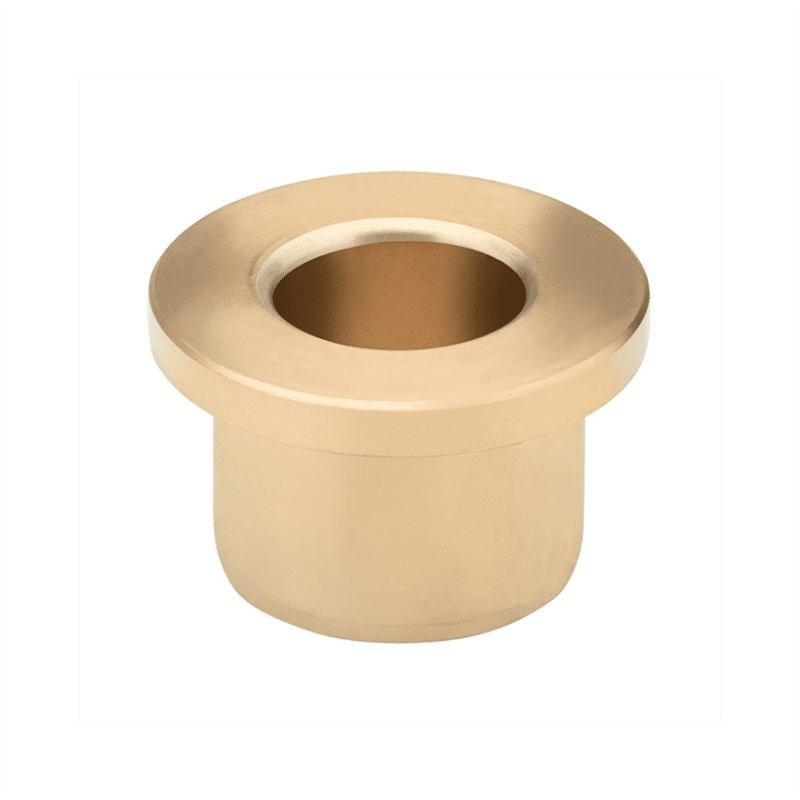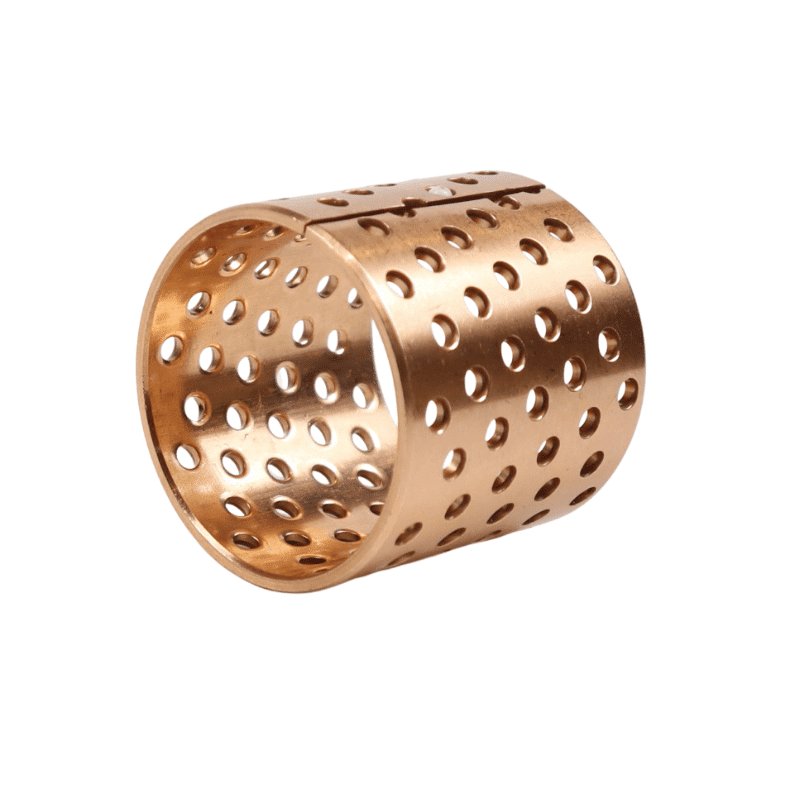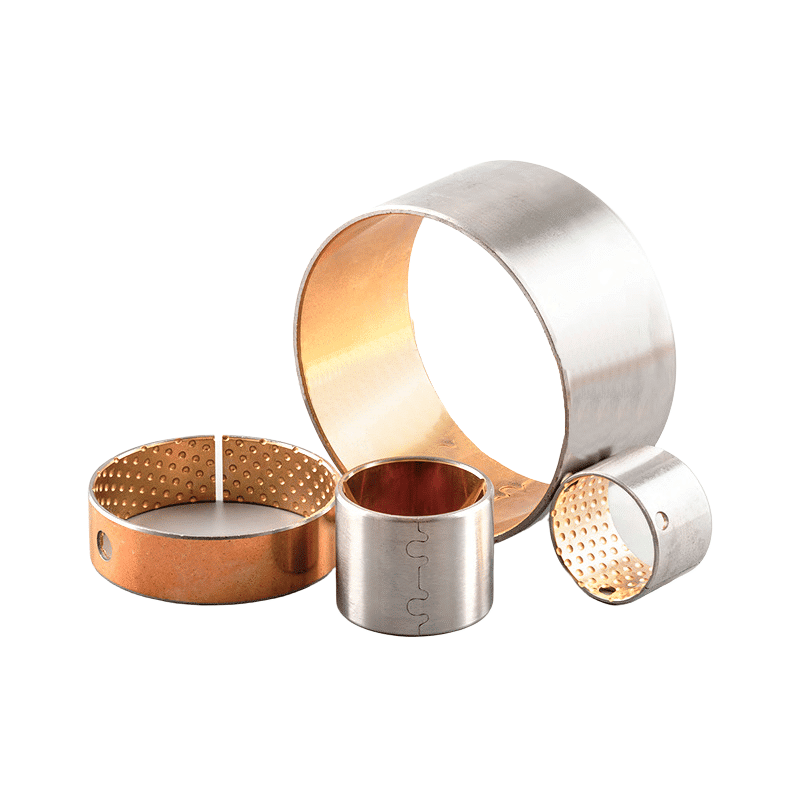Bushings for Hydraulic pumps
Bushings for Hydraulic pumps
Say goodbye to the hassle of frequent lubrication maintenance. Our self-lubricating technology ensures smooth operation and reduces wear and tear, extending the lifespan of your equipment. Experience uninterrupted productivity and cost savings as you bid farewell to the need for messy lubricants and time-consuming upkeep.
Manufacturing on Demand, alternative solutions
Bushings for Hydraulic pumps
Hydraulic pumps and their components, including self-lubricating bearings, play a crucial role in various industrial applications by providing efficient, reliable, and maintenance-free operation. Self-lubricating bearings are designed to minimize friction and wear between moving parts without the need for additional lubrication. This feature is particularly beneficial in hydraulic systems, where traditional lubrication methods may not be feasible or sufficient.
A metal-polymer plain bearing material has been developed for use in both industrial and automotive applications, such as hydraulic pumps and motors, fuel injection pumps, power steering pumps, compressors, hydraulic cylinders, and shock absorbers. This composite material consists of a steel base with a sintered porous bronze interlayer that is impregnated and coated with a PTFE (Polytetrafluoroethylene) bearing layer. This layer includes fluoropolymers and other fillers, designed through a specialized formulation and process to enhance the bearing’s performance in lubricated conditions. The steel backing offers mechanical strength, while the bronze sintered layer, infused with PTFE and other fillers like CaF2 and additional fluoropolymers, ensures a robust mechanical bond. These bearings, including banded flange bushings and cylindrical bushings, are produced in compliance with international standards, ensuring their quality and reliability in various mechanical applications.
Bushings for Hydraulic pumps, Metal-Polymer Bearing Solutions for Lubricated Applications
PTFE bushings, Bushings for Hydraulic pumps, black low carbon steel lining PTFE, Bushings for hydraulic pumps are crucial components that reduce friction and wear, ensuring smooth operation. or polytetrafluoroethylene bushings, are designed from a material known for its low friction and ability to endure wide temperature ranges. These bushings are chosen for numerous industrial uses due to their impressive attributes like chemical stability, exceptional resistance to environmental factors, superior electrical insulation, heat resistance, non-stick properties, and minimal friction coefficient. However, when subjected to heavy loads, PTFE bushings may deform, a drawback that can be countered by integrating fillers to improve the bushing’s characteristics.
The integration of PTFE (Polytetrafluoroethylene) with fillers such as CaF2 (Calcium Fluoride) and porous bronze, combined with a steel backing, creates a sophisticated material system for self-lubricating bearings in hydraulic pumps and other demanding applications. This combination leverages the unique properties of each component to enhance performance, durability, and application suitability.
In hydraulic pumps, bushings play a pivotal role in maintaining the correct spacing within the pump assembly and averting leaks. They can be crafted from various materials like low carbon steel, bronze, bimetal, or synthetic substances such as PTFE and Nylon, tailored to the operational conditions of the pump. PTFE bushings are particularly advantageous in environments with abundant water or corrosive agents, as their self-lubricating nature and consistent low friction performance, unaffected by water presence, make them ideal for submerged settings.
Specifically, for hydraulic pumps with a black low carbon steel liner, incorporating PTFE bushings can bring the benefit of substantial load-bearing capability due to the steel foundation, while the PTFE coating adds the necessary low friction and self-lubrication for effective pump functioning. The steel support also facilitates effective heat dissipation, with potential enhancements in corrosion resistance through additional coatings like copper or tin.
Choosing the correct bushings for hydraulic pumps necessitates an in-depth understanding of the application’s specific needs, including the operational environment and the materials interacting with the bushings. Seeking expert advice is crucial to select the most suitable bushings, ensuring they possess the right materials and features to maximize the pump’s performance and durability.
Bushings designed for hydraulic pumps are made from a composite material that includes a steel backing bonded with a porous bronze interlayer, which is then impregnated and coated with a PTFE bearing layer enriched with fluoropolymer and various fillers. This PTFE layer is engineered using a unique formulation and processing technique to boost the bearing’s performance in lubricated conditions. The steel backing ensures structural durability, while the bronze sinter layer forms a robust bond with the PTFE layer enriched with additives.
The PTFE composite is enhanced with additives like CaF2 (Calcium Fluoride), chosen for applications where glass isn’t suitable due to chemical resistance demands, particularly in seals and electrical contexts where chemical resistance is paramount. Porous bronze serves as a filler to increase wear resistance, thermal conductivity, and resistance to pressure and creep, offering superior friction resistance over other PTFE blends. Adding MoS2 (Molybdenum Disulfide) can further diminish friction, although bronze’s oxidation potential should be noted.
The steel backing not only provides structural support but also bolsters the bearing’s wear resistance, allowing it to handle higher loads and offering improved chemical resistance, especially in high-load or steam environments.
The sintering process fuses bronze alloy powder to the steel backing below its melting point, creating a dual-layer material that marries steel’s strength with the self-lubricating features of the bronze-PTFE layer. This porous bronze sinter serves as a supportive intermediary, bolstering the PTFE layer’s thermal conductivity, crucial for heat dissipation during operation.
These materials are ideal for self-lubricating bearings in hydraulic pumps, reducing maintenance needs and boosting efficiency. The low friction of PTFE, combined with the thermal conductivity and wear resistance of bronze and steel’s structural integrity, makes these bearings apt for various industrial uses, especially where lubrication is challenging or exposure to corrosive elements is likely.
In essence, this material system, integrating PTFE with CaF2 and porous bronze fillers on a steel backing, offers a superior solution for self-lubricating bearings, enhancing performance through reduced friction, increased wear resistance, and greater durability, making it ideal for demanding settings like hydraulic pumps.
We offer self-lubricating bearings designed to deliver superior performance even under the most challenging marginally lubricated operating conditions. These bearings are ideal for a wide range of applications, such as:
- McPherson struts and shock absorbers
- Hydraulic cylinders
- Hydraulic pumps and motors
- Fuel injection pumps
- Power steering pumps
- Compressors
- Engine valve-train bearings
- Transmission bearings
These bearings are engineered to ensure optimal functionality and longevity in various mechanical systems, providing reliable performance across a spectrum of industrial and automotive applications.
Self-Lubricating Bearings for Hydraulic Pumps: Essential Characteristics and Advantages
Reduced Friction: These bearings are designed with minimal friction coefficients to boost energy efficiency and the overall functionality of the system.
Durability Against Wear: Made from durable materials like bronze, stainless steel, and polymer composites, these self-lubricating bearings demonstrate excellent resistance to wear, prolonging their lifespan and minimizing the need for frequent replacements.
No Maintenance Required: The self-lubricating feature of these bearings removes the necessity for routine lubrication, thus reducing maintenance expenses and operational downtime.
Adaptability: Available in a variety of shapes and sizes, these bearings are suitable for a multitude of hydraulic applications, such as in cylinders, pumps, motors, and heavy machinery.
Environmental Considerations: Hydraulic self-lubricating bearings that are lead-free cater to eco-friendly industries by providing a harmless alternative to conventionally lubricated bearings.
Usage and Composition of Materials
Self-lubricating bearings are employed in various hydraulic components and heavy machinery, including excavators and loaders, and are also utilized in the aerospace and automotive sectors for suspension systems and other dynamic parts.
These bearings are typically made from robust, corrosion-resistant metals like steel, stainless steel, or bronze, with a lead-free solid lubricant like PTFE, graphite, or MoS2 integrated or coated onto the base metal to enable self-lubrication.
Performance Metrics
The static load capacity reaches up to 250N/mm², while the dynamic load capacity is up to 140N/mm².
Under dry conditions, the maximum PV value is 3.8N/mm².m/s, increasing to 60N/mm².m/s in oil.
The highest linear speed is 2m/s in dry conditions and 5m/s in oil.
Friction coefficients vary between 0.08 and 0.22 in dry conditions and 0.02 to 0.07 in oil.
The bearings operate effectively in temperatures ranging from -200°C to +280°C.
BEARING SELF-LUBRICATING PTFE BUSH / COPPER-BEARING BUSH
Hydraulic self-lubricating bearings are a practical, efficient, and eco-friendly option for minimizing friction and wear in hydraulic systems. Their low maintenance needs, significant wear resistance, and adaptability make them an excellent selection for various industrial uses. Choosing the right self-lubricating bearings can lead to enhanced processing efficiency, decreased operational costs, and improved durability of equipment.
Purpose: Bushings play a crucial role in hydraulic pumps by supporting and aligning moving components, diminishing friction, and averting direct metal contact.
Varieties: There are multiple types of bushings, such as precision pump bushings, gear pump bushings, and steel bushing reducers.
Material Choices: These bushings are typically made from materials like bronze, brass, and steel, some of which possess self-lubricating features.
Significance: Choosing and maintaining the right bushings is vital as they prolong the pump’s lifespan, boost its efficiency, and cut down on maintenance expenses.
Supply: There is a wide array of hydraulic bushings available from suppliers, designed to fit different pump models and applications, ensuring they meet specific needs for compatibility and dependability.
It’s essential to select hydraulic pump bushings with accurate sizing and compatibility to ensure the pump operates at peak performance and reliability.
Exploring Alternative Bushing Materials for Hydraulic Pumps
When selecting bushing materials for hydraulic pumps, it’s essential to consider factors such as exposure to water and corrosive elements. Synthetic or bronze bushings are preferable over steel and brass in environments where water or abrasive materials like dirt or sand are present. Bushings for submersible pumps, often crafted from synthetic materials like nylon and PTFE, are particularly suited for underwater use due to their self-lubricating nature and consistent low friction coefficient, regardless of water contact.
Bushings can be constructed from a variety of materials, including steel, bronze, bimetal, PTFE, and nylon, tailored to the specific requirements of the pump and its operational context. Bronze bushings are valued for their high load capacity, resistance to wear and corrosion, and self-lubricating capabilities, making them an excellent choice for automotive uses where enhanced performance and durability are needed.
Polytetrafluoroethylene (PTFE) bushings provide a high-performance option with a design that combines PTFE lining and metal backing, minimizing maintenance needs, enhancing efficiency, and available in multiple sizes for diverse applications. For those seeking alternatives to PTFE, there are high-quality bushings that offer outstanding performance, durability, cost-efficiency, longevity, versatility, and eco-friendliness.
A case study from a refinery in Genoa, Italy, demonstrates the significance of proper bushing material choice. The facility encountered frequent failures with water-lubricated metal and rubber bearings in a vertical pump due to dry running, attributed to intermittent level control system issues. This situation resulted in recurrent bearing replacements and emphasized the need for selecting appropriate bushing materials to improve Mean Time Between Repairs (MTBR) in vital applications.
Your expert in self-lubricating Bearing
and Bronze alloys – serving globally
Brand replacement products and functionally equivalent parts, alternative solutions
Manufactures flange bronze bearings, service & maintenance companies to meet the exacting specifications required in a wide range of industrial applications.
Machined bronze bushing that meet the exacting requirements & specifications supplied by our clients. Spherical bearings, spindles, semi-spheres and supports that we have manufactured.
You will find to follow a selection of self lubricating bronze bearing material CuSn7Zn4Pb7, CuSn12, CuAl10Fe5Ni5,
CuZn25Al5Mn4Fe3
Alternative solution,We offer an outsourced machining service for bronze bushes, manufacturing precise parts to the designs supplied to us by our clients.
Selection of other composite bushing material of self lubricating bearing that we have manufactured.
Wrapped Bronze Sleeve Bearing, Are you interested in our products?
Manufacturer of bimetal and steel bronze bushing parts according to client’s drawing.

